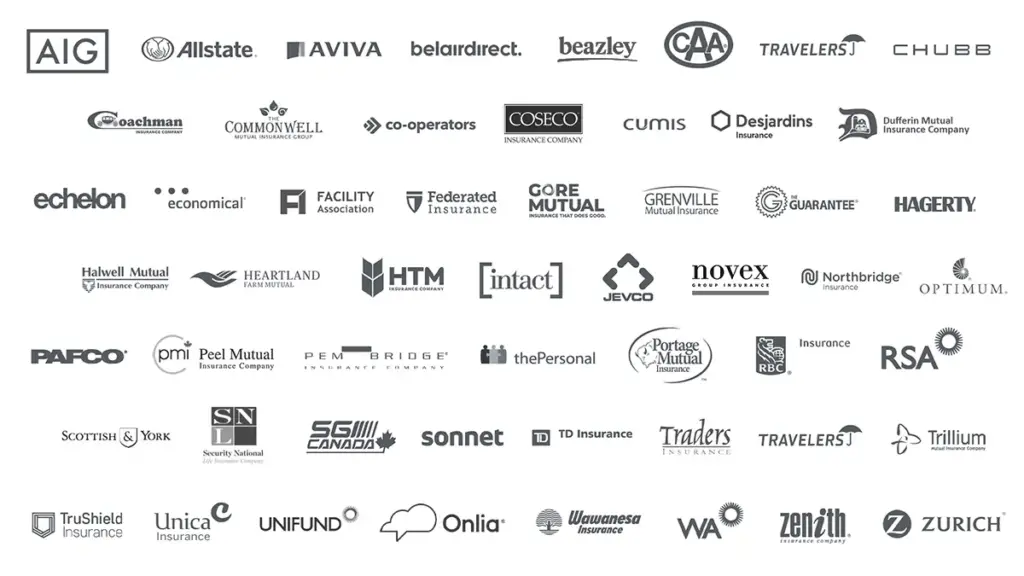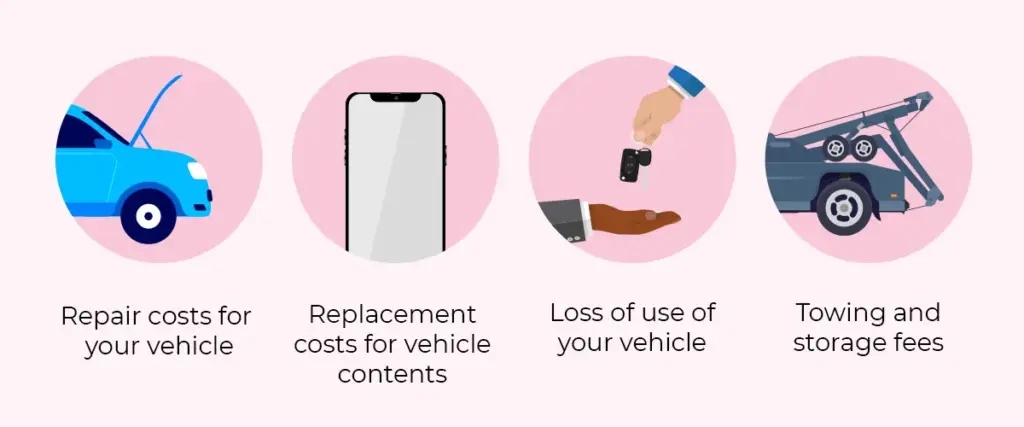In today’s cost of living crisis, saving money where possible is essential. Insurance is a mandatory purchase, but it doesn’t have to break the bank. To save money on your insurance, you’ll want to work with the best auto insurance company. But who’s the best of the best?
Below is a breakdown of the best car insurance companies in Ontario, including what they offer, how they rank by coverage options, price, and more.
- How do you choose the “best” auto insurer?
- Beyond rates: What makes an auto insurance company the right choice?
- Customer service studies
- Size of insurance company
- Online insurance reviews
- Ontario auto insurance companies compared
- Who is the best auto insurance company in Ontario for 2024?
- Best auto insurance companies by demographic
- Female drivers under 25
- Female drivers over 25
- Male drivers under 25
- Male drivers over 25
- Senior drivers (over 65)
- Different companies may specialize in different types of drivers
- Regular (standard) market auto insurance companies
- High-risk auto insurance companies
- Specialty insurance companies
- Motorcycle insurance companies
- Ridesharing vehicle insurance companies
- Business vehicle insurance companies
- Farm vehicle insurance companies
How do you choose the “best” auto insurer?
There are more than 80 insurance companies in Ontario that sell auto insurance. Each insurance company has its own “offering,” and certain insurers only offer niche auto insurance (such as high-risk, right-hand drive, or classic car insurance).
When you want the best, you need to know what it means to be the “best.” The insurer you choose should be able to:
- Meet your (insurance) needs
- Offer budget-friendly rates
- Provide excellent customer and claims service
Beyond rates: What makes an auto insurance company the right choice?
While an insurance broker’s duty is to help find you great rates, they can also help partner you with an insurer who will find you the best coverage fit. This goes beyond price. There are other ways to rank auto insurance companies beyond their price. Keep the following in mind:
1. Customer service studies
J.D. Power, a software, consumer intelligence, and data analytics company, conducts their own customer satisfaction surveys every year for auto insurance companies. While their rankings may only serve as a general guideline, it’s good to take note of common trends. Note that J.D. Power ratings do have their own limitations, such as:
- Their surveys are only conducted using a very small sample size (minimum of 100 respondents). Given Ontario is as large as it is, sample sizes would need to be at least 1,000 to be reliable.
- J.D. Power provides detailed results in exchange for a fee, so surveys are not intended for everyday consumers.
- J.D. Power uses virtual panels to collect data, which tend to be less reliable than other means.
- J.D. Power currently only has ratings for 13 of the 80+ car insurance companies in Ontario.
2. Size of insurance company
This is a factor that too few policyholders know about, but it’s important. When insurance companies are smaller, the funds that they have to payout claims also tends to be smaller. The risk that the insurance company may not have enough money to pay out all claims is greater. Larger companies tend to have a more evenly spread risk, and have also likely purchased reinsurance, so there’s less risk for the insured. This, of course, isn’t always an exact science – and sometimes the smaller guys will meet your needs even better than the big guys!
3. Online insurance reviews
While reviews are not solely about what drivers should go off, they can be an indicator of the kind of service you might expect from an insurance company. They can be skewed because:
- Many customers will only leave a review after a bad experience
- The larger the company, the more customers they have – and the worse reviews they’ll get
- Insurance is complicated, and oftentimes reviews are based off people’s limited knowledge of how different coverages function
The best you can take away from online reviews is how insurance companies “argue” over what’s covered when a claim is filed and how easy they are to contact. Reviews may be able to show how well (or poorly) an insurance company fares for these aspects.
Ontario auto insurance companies compared
There’s no definitive way to say which auto insurance company is the best. We’ve created the table below to show the differences between different auto insurers. Note that we can only access pricing information from the auto insurers that we partner with:
Table 1. Ontario auto insurance companies compared
| Insurance Company |
Type of Insurance Sold |
How to Buy1 |
J.D. Power Rating2 |
Google Rating3 |
Size (by premiums) |
| AIG Canada |
Business |
Broker |
|
1.8 / 5
(46) |
Small |
| Allstate Insurance Co. of Canada |
Regular, motorcycle |
Agent, Direct |
762/1000 |
3.9 / 5
(2,446) |
Medium |
| Aviva Canada |
Regular, motorcycle, specialty, business, ride-sharing |
Broker |
751/1000 |
4.1 / 5
(3,361) |
Large |
| Belairdirect |
Regular, ride-sharing |
Broker |
779/1000 |
4.2 / 5
(6,174) |
Large |
| Beazely Canada |
Business |
Broker |
|
5 / 5
(1) |
Small |
| CAA Insurance |
Regular |
Broker |
|
4.2 / 5
(6,414) |
Medium |
| Travelers Essential |
Regular |
Broker |
|
2.5 / 5
(234) |
Small |
| Chubb Insurance Co. of Canada |
Business |
Broker |
|
2.6 / 5
(116) |
Small |
| Coachman Insurance Co. |
High-Risk |
Broker |
|
2.4 / 5
(32) |
Small |
| Commonwell Mutual Insurance Group |
Regular, business |
Broker |
|
3.0 / 5
(101) |
Small |
| The Co-operators Insurance |
Regular, business |
Direct |
809/1000 |
4.3 / 5
(4,420) |
Large |
| Coseco Insurance |
Regular |
Broker |
|
2.9 / 5
(143) |
Small |
| CUMIS |
Regular |
Broker |
|
3.6 / 5
(18) |
Small |
| Desjardins Insurance |
Regular, motorcycle |
Agent, Direct |
748/1000 |
4.8 / 5
(16,859) |
Large |
| Dufferin Mutual Insurance Co. |
Regular, business |
Broker |
|
2.7 / 5
(11) |
Small |
| Echelon Insurance Co. |
High-Risk, motorcycle, specialty |
Broker |
|
1.9 / 702
(75) |
Medium |
| Economical Insurance |
Regular, High-risk, business |
Broker |
793/1000 |
2.1 / 5
(694) |
Large |
| Facility Association |
High-Risk, motorcycle, specialty |
Broker |
|
1.9 / 5
(9) |
Medium |
| Federated Insurance |
Regular, business |
Broker |
|
4.3 / 5
(44) |
Small |
| Gore Mutual Insurance Co. |
Regular, business |
Broker |
|
2.5 / 5
(431) |
Medium |
| Grenville Mutual Insurance Co. |
Regular |
Broker |
|
3.7 / 5
(32) |
Small |
| The Guarantee Co. |
Regular |
Broker |
|
2.2 / 5
(14) |
Small |
| Hagerty |
Specialty |
Broker |
|
4.6 / 5
(315) |
Small |
| Halwell Mutual Insurance Co. |
Business |
Broker |
|
3.8 / 5
(12) |
Small |
| Heartland Farm Mutual Inc |
Regular |
Broker |
|
3.0 / 5
(72) |
Small |
| HTM Insurance Co. |
Business |
Broker |
|
4.3 / 5
(16) |
Small |
| Intact Insurance |
Regular, motorcycle, specialty, business, ride-sharing |
Broker |
768/1000 |
3.3 / 5
(1,630) |
Large |
| Jevco Insurance |
High-Risk |
Broker |
|
2.6 / 5
(184) |
Medium |
| Novex Insurance Co. |
Regular |
Broker |
|
1.3 / 13
(6) |
Small |
| Northbridge Insurance |
Regular, business |
Broker |
|
3.7 / 5
(292) |
Medium |
| Optimum General Insurance |
Regular |
Broker |
|
3.0 / 5
(18) |
Small |
| Pafco Insurance |
High-Risk |
Broker |
|
1.8 / 5
(178) |
Medium |
| Peel Mutual Insurance Co. |
Regular, business |
Broker |
|
2.7 / 5
(40) |
Small |
| Pembridge Insurance Co. |
Regular, motorcycle |
Broker |
|
1.7 / 5
(754) |
Medium |
| The Personal |
Regular, motorcycle |
Broker |
798/1000 |
3.1 / 5
(825) |
Small |
| Portage Mutual Insurance |
Regular, business |
Broker |
|
3.4 / 5
(14) |
Small |
| RBC Insurance |
Regular |
Direct |
794/1000 |
3.5 / 5
(562) |
Medium |
| RSA Canada |
Regular, motorcycle, business |
Broker |
|
2.8 / 5
(121) |
Medium |
| Scottish & York |
Regular |
Broker |
|
1 / 5
(1) |
Small |
| Security National |
Regular |
Direct |
|
– |
Large |
| SGI Canada |
Regular |
Broker |
|
3.2 / 5
(317) | Small |
| Sonnet Insurance |
Regular |
Direct |
|
– |
Large |
| TD General Insurance |
Regular, motorcycle |
Direct |
763/1000 |
3.6 / 5
(2,273) |
Large |
| Traders General Insurance Co. |
Regular |
Broker |
|
– |
Small |
| Travelers Canada |
Regular, motorcycle, specialty, business |
Broker |
779/1000 |
2.4 / 5
(216) |
Medium |
| Trillium Mutual Insurance Co. |
Regular, business |
Broker |
|
3.3 / 5
(29) |
Small |
| Trushield Insurance |
Regular, business |
Broker |
|
4.4 / 5
(292) |
Small |
| Unica Insurance |
Regular, business |
Broker |
|
4.1 / 5
(188) |
Small |
| Unifund Assurance |
Regular |
Broker |
|
– |
Small |
| Onlia Insurance (Onlia) |
Regular |
Agent |
|
3.3 / 5
(484) |
Small |
| Wawanesa Insurance |
Regular, business |
Broker |
751/1000 |
2.0 / 5
(414) |
Medium |
| Western Assurance |
Regular |
Broker |
|
2.2 / 5
(19) |
Small |
| Zenith Insurance Co. |
Regular, motorcycle |
Broker |
|
1.4 / 5
(19) |
Small |
| Zurich Canada |
Business |
Broker |
|
4.3 / 5
(19) |
Small |
| 1Agents sell through a network of agents that only sell their products. Brokers sell through independent brokers, who also offer quotes from other insurance companies. Direct means they sell directly to the public, usually online or by phone; 2Overall customer satisfaction index ranking, Ontario region – J.D. Power 2019 Canada Auto Insurance Satisfaction Study. (Note: J.D. Power Ratings are only available for companies that got a minimum of 100 responses from the consumer survey); 3Average Google rating for all Ontario locations as of February 2024. |
Who is the best auto insurance company in Ontario for 2024?
There is no single best auto insurance company in Ontario that works for everyone, as everybody’s personal insurance needs are just that: personal. What works for Bob and Jerry down the road may not work for you, as your driving habits may be different, your driving experience, the cars you drive, etc. The table below shows pricing comparisons between some of our partners for different demographics:
Table 2. Average Ontario auto insurance rates for male, female, and senior drivers1
| Insurance company |
Rates for females (over 25) |
Rates for females (under 25)2 |
Rates for males (over 25) |
Rates for males (under 25) |
| Aviva |
$3,537 |
$4,296 |
$3,315 |
$4,279 |
| CAA |
$2,758 |
$4,990 |
$2,758 |
$6,078 |
| Economical |
$3,461 |
$4,695 |
$3,525 |
$4,775 |
| Intact |
$3,348 |
$3,686 |
$3,051 |
$3,629 |
| Pembridge |
$3,924 |
$4,658 |
$3,783 |
$4,345 |
| SGI Canada |
$3,083 |
$3,969 |
$3,072 |
$3,676 |
| Travelers |
$4,812 |
$6,276 |
$4,916 |
$6,372 |
| Wawanesa |
$2,899 |
$3,577 |
$3,192 |
$3,893 |
| 1Data source: Mitch auto insurance quoter (ranked by price in parentheses) ;2Rates for younger females are typically lower than those for young males. Quotes shown are higher because of the specific driver profiles chosen. |
Get an auto insurance quote in minutes.
Best auto insurance companies by demographic
As different insurance companies tend to go after different demographics, no one company offers the best, most affordable rates for every driver. If you’re a female under 30, you might not enjoy the same rates as your neighbour, Derek, who’s 55.
The only way to find your best rate is to get a quote from as many different companies as possible. If you contact a direct insurer or an insurance agent, you will only get the price for that one insurance company. Also, note that online quotes are notoriously inaccurate. You won’t have a really good idea of actual price unless you call.
As different insurance companies tend to go after different demographics, no one company offers the best, most affordable rates for every driver. If you’re a female under 30, you might not enjoy the same rates as your neighbour, Derek, who’s 55.
How do you tell which insurance company is best for your needs? Get a different quote from as many insurance companies as possible. You can technically do this by calling around to the individual insurers, but this is a long, tedious process, and online quotes are usually inaccurate.
Your best bet is to go through an insurance broker, specifically one that works with plenty of different insurance companies. Mitch is trusted by thousands of policyholders because it represents more than 70 different insurers, where some brokers will only work with a few.
Here’s a breakdown of what you might expect from different insurers based on gender/age:
To give you an idea of what you can expect from different insurers based on your gender and age, we ran a variety of quotes in our online auto insurance quoter, and found the following:
Female drivers under 25:
- Wawanesa has the best rates for female drivers under 25.
- Different female drivers with different demographics may get their best rates for different insurers. Of all the companies we ran, Wawanesa, SGI, and Intact had the best rates.
Read more: The best insurance companies for younger drivers in Ontario in 2023
Female drivers over 25:
- CAA has the best rates for female drivers over 25.
- Again, rates will differ depending on the female driver. While CAA had the lowest rates on average for our female driver, Wawanesa and SGI were close contenders.
Read more: The best insurance companies for female drivers in Ontario in 2024
Male drivers under 25:
- Intact has the best rates for male drivers under 25.
- Rates will differ by more than just your gender and age. Intact had the most affordable rates for men in this demographic but SGI and Wawanesa weren’t far behind.
Read more: The best insurance companies for younger drivers in Ontario in 2023
Male drivers over 25
- CAA has the best rates for male drivers over 25.
- Intact, SGI, and Wawanesa were also some of the top companies for male drivers over 25.
Read more: The best insurance companies for male drivers in Ontario in 2024
Senior drivers (over 65)
- After running a few quotes to compare prices for male and female drivers over 65, we found that the most affordable company for men and women over 65 was CAA. Aviva, Intact, and SGI also offered good rates.
Read more: The best insurance companies for older drivers in Ontario in 2023
Different companies may specialize in different types of drivers
All drivers with a valid Ontario license are entitled to fair access to insurance. Different insurers will specialize in different types of “risk,” meaning some companies may offer insurance to drivers who would otherwise have a difficult time getting insured through the regular market. In the chart above, we included which companies are open to business in different categories. Here’s a breakdown of those different categories:
1. Regular (standard) market auto insurance companies
Most drivers in Ontario are insured through what is known as the standard market. This means that the companies who offer “standard” insurance will offer it to low or medium-risk drivers, so drivers who don’t use their cars for business usage, aren’t right-hand drive, don’t have modifications, or who don’t have more than three tickets/at-fault accidents on their record.
2. High-risk auto insurance companies
High-risk auto insurance, also called nonstandard auto insurance, is offered by companies who specialize in insurance for drivers whose risk profile would otherwise be uninsurable by standard market companies. This is usually due to serious driving convictions, at-fault accidents, or having been cancelled due to a history of non-payment.
3. Specialty insurance companies
Some insurance companies specialize in offering insurance to what are known as non-standard vehicles, which are often right-hand drive, classic/collector vehicles, or vehicles that have been heavily modified.
4. Motorcycle insurance companies
In Ontario, motorcycle insurance tends to rack higher than car insurance on average as accidents can involve severe injuries, and may include the potential for long-term disability. Motorcycle insurance, as a result, can be riskier – even with more experienced drivers.
Few insurers will insure drivers under 25 or who have less than 5 years of riding experience. In this case, they may need to obtain coverage through Facility Association as their only option.
5. Ridesharing vehicle insurance companies
If you use your personal vehicle for ridesharing companies such as Lyft or Uber, and you transport either food or passengers, then many insurers may not agree to work with you, and you’ll have to acquire specialized insurance through a rideshare insurer. This tends to be more expensive than standard auto insurance.
6. Business vehicle insurance companies
Using a car for business purposes, such as owning a vehicle with business branding, hauling goods, tools, or delivering passengers, calls for commercial auto insurance. Many auto insurers specialize in insuring business vehicles.
7. Farm vehicle insurance companies
There are quite a few options for farmers wanting to insure their farm-use vehicles, with over 40 farm mutuals operating in Ontario. Note a few of these mutuals only operate in their immediate geographic region. Some business vehicle insurers will also cover farm vehicles as well.
Different companies may specialize in different types of drivers
While it can be tough to choose a car insurance company that’s right for you, Mitch can help. We partner with many of Canada’s top auto insurance providers, so we’re confident we can help you find a company that fits the bill and for a great rate, too.





















